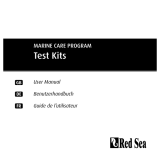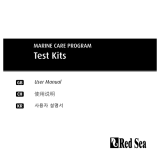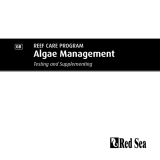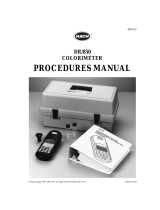
MARINE CARE PROGRAM
Test Kits
User Manual
GB


Test Kits | 1
Red Sea’s Marine Care Program
Red Sea’s Marine Care Program includes easy to use tests for the accurate monitoring
of all of the important parameters during the biological maturation of marine and reef
aquariums and for ongoing maintenance in Marine sh and Mixed reef systems.
See Red Sea’s Reef Mature Starter kit for a complete step-by-step maturation cycle
program.
Important notes for using the Marine Care Program Test Kits
• Before testing clean the glass vials and the large syringe by rinsing it with the water to
be tested.
• After testing rinse all syringes and vials with RO or distilled water before storing.
If vials are left unwashed a residue can form that will affect the results of future tests.
Use a slightly acidic solution such as vineger to remove the residue.
• In order to ensure an accurate drop size always hold reagent bottle vertically above the
test vial, and gently squeeze out each drop .
• Close all reagents tightly immediately after use.
• The test reagents are stable up to the date stated on the pack when stored closed
between 15 – 25 °C.
• Store the reagents and color card in the box to prevent damage from prolonged
exposure to light.

Red Sea | Marine Care Program
pH Test – directions for use
1. Using the syringe provided, place exactly 5 ml of the water to be tested into the glass vial.
2. Add 3 drops of pH indicator close the vial with the cap and shake for 10 seconds.
3. Remove the cap and move the vial between the designated positions on the color card,
look into the vial from above and compare the color in the vial to the colors on the card.
Choose the pH level that gives the closest color match and if necessary estimate an
intermediate value.
4. The color in the reaction vial will remain stable for 5 minutes. Do not relate to the color in
the reaction vial after this time
KH Test – directions for use
Red Sea’s Marine Care KH test kit provide an easy measurement of °KH with a resolution of
either 0.5 or 1 °KH as desired
1. Using the syringe provided, place exactly 10 ml of the water to be tested into the glass vial
in order to measure °KH levels in 0.5 °KH resolution, or 5 ml of the water to be tested in
order to measure °KH levels in 1 °KH resolution.
2. Draw KH indicator into the dropper.
3. Add 1 drop of KH indicator and shake for 10 seconds. The test sample will obtain the
titration “start” color as shown on the instruction card.
4. Continue to add KH indicator one drop at a time (shake for 10 seconds after each drop)
until the color of the sample in the glass vile changes to the corresponding “end” color as
shown on the instruction card. Count the number of drops required to reach the end color.
5. Return any unused indicator to the bottle and ensure that the bottle is closed tightly.
6. Each drop of indicator corresponds to 0.5 °KH (0.18 meq/L) or 1°KH (0.36 meq/L) depends
on the water sample volume.
7. If the last drop gave the overdose color instead of the end color reduce the calculated
level by 0.25 °KH (0.09 meq/L) for 0.5°KH resolution or 0.5°KH (0.18 meq/L) for 1°KH
resolution.
Note: The Alkalinity test kit enables accurate dosing of Red Sea’s KH-Coralline Gro in Marine Fish
systens and Foundation™ KH/Alkalinity Buffer Supplements in Mixed Reefs.

Test Kits | 3
Nitrate Test – directions for use
1. Using the syringe provided, place exactly 5 ml of the water to be tested into
the glass vial.
2. Add 5 drops of NO2/NO3 reagent A, close the vial with the cap and shake
for 10 seconds.
3. Add a leveled measuring spoon of NO3 Reagent B, close the vial with the cap
and shake vigorously for 60 seconds.
4. Add a leveled measuring spoon of NO2/NO3 Reagent C, close the vial with
the cap and shake vigorously for 10 seconds.
5. Wait 9 minutes for the color in the vial to stabilize.
6. Remove the cap from the reaction vial and shake the vial gently to release
tiny air bubbles and reagent particles that settled on the bottom.
7. Move the vial between the designated positions on the Nitrate color card,
look into the vial from above and compare the color in the vial to the colors
on the card. Choose the Nitrate level that gives the closest color match and if
necessary estimate an intermediate value. The color is stable for 2 minutes.
High Range: For levels of Nitrate above 50 ppm dilute 1 ml of the water to be
tested with 4 ml of RO water. Multiply the result by 5 for true nitrate level.
Note: The Nitrate test kit is suitable for ongoing algae management with Red Sea’s
NO3:PO4-X Mixed Reefs and Marine Fish systems.

Red Sea | Marine Care Program
Nitrite Test– directions for use
1. Using the syringe provided, place exactly 16 ml of the water to be tested into the glass vial.
2. Add 1 drops of NO2/NO3 reagent A, close the vial with the cap and shake for 10 seconds.
3. Add a leveled measuring spoon of NO2/NO3 Reagent C, close the vial with the cap and shake
vigorously for 10 seconds.
4. Wait 9 minutes for the color to develop.
5. Remove the cap and move the vial between the designated positions on the Nitrite color
card, look into the vial from above and compare the color in the vial to the colors on the
card. Choose the Nitrite level that gives the closest color match and if necessary estimate an
intermediate value. The color is stable for 2 minutes.
Ammonia Test – directions for use
1. Using the syringe provided, place exactly 5 ml of the water to be tested into the glass vial.
2. Add a leveled measuring spoon of Ammonia Reagent A, close the vial with the cap and
shake for 10 seconds.
3. Add 5 drops of Ammonia Reagent B, close the vial with the cap and shake for 10 seconds.
4. Add 5 drops of Ammonia Reagent C, close the vial with the cap and shake for 10 seconds
5. Wait 15 minutes for the color in the vial to stabilize.
6. Remove the cap and move the vial between the designated positions on the color card,
look into the vial from above and compare the color in the vial to the colors on the card.
Choose the Ammonia level that gives the closest color match and if necessary estimate an
intermediate value.
7. The color in the reaction vial will remain stable for 5 minutes. Do not relate to the color in the
reaction vial after this time
Note: This kit measures the total ammonia (NH3/NH4). For Marine aquariums – any reading of
0.25 ppm or above of total Ammonia indicates a level of toxic Ammonia of at least 0.01 ppm
which will have a negative effect on the sh. To calculate the exact amount of toxic Ammonia in
the aquarium water, use the following table to nd the percentage of toxic Ammonia in the total
dissolved Ammonia which is based on the current temperature and pH of the aquarium water.

Test Kits | 5
Example:
1. You have measured a total Ammonia level of 1 ppm, a pH of 8.4 and a temperature
of 26 degrees Celsius.
2. The table gives 14% toxic Ammonia (see shaded area of the table).
3. The toxic Ammonia level is 14 % of 1 ppm = 0.14 ppm. This level is toxic to sh.
Table : Percentage of toxic Ammonia, at different temperatures and pH values
Temperature
ºC / ºF 20º / 68º 23º / 73º 26º / 79º 29º / 89º
7.2 0.6 0.8 1.0 1.2
7.4 1.0 1.2 1.5 1.8
7.6 1.6 1.9 2.3 2.8
7.8 2.5 3.0 3.7 4.6
8.0 3.8 4.7 5.8 7.0
8.2 5.9 7.2 8.8 7.7
8.4 9.1 11 14 16
8.6 14 16 20 23
8.8 20 24 28 32
pH value

# 24725 _v20a
Red Sea U.S.A
4687 World Houston
Parkway #150
Houston, TX 77032, U.S.A
support.usa@redseash.com
Red Sea Europe
655 Rue des Frères Lumière
27130 Verneuil d’Avre et d’Iton,
France
support.fr@redseash.com
Red Sea Aquatics (UK)
PO Box 1237
Cheddar, BS279AG
United Kingdom
uk.info@redseash.com
International
Free Trade Industrial Zone
Eilat 8814001, Israel
Tel: +972 9 956 7107
ofce@redseash.co.il
Red Sea Deutschland
Büro Deutschland
Prinzenallee 7 (Prinzenpark)
40549 Düsseldorf
support.de@redseash.com
/




